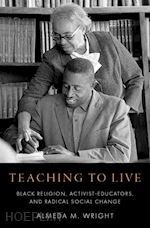Teaching to Live: Black Religion, Activist-Educators, and Radical Social Change interrogates the stories of African American activist-educators whose faith convictions inspired them to educate in radical and transformative ways. Many of these educators are known only or primarily for their educational theory or activism, and their religious convictions have often been obscured or outright ignored. Almeda M. Wright seeks to rectify this omission, exploring the connections between religion, education, and struggles for freedom within twentieth-century African American communities by telling the stories of key African American teachers. Wright brings together the lives and work of three related subgroups of activist-educators: those who worked in public or secular education but were religiously inspired; radical scholars who transformed the ways that Black religion and Black religious life are studied and valued; and radical religious educators, or those educators who were involved more formally with the religious formation of Black people but who regarded this work of spiritual development as part of the struggle for freedom and liberation of all people. She begins with the reflections of Anna Julia Cooper, W. E. B. Du Bois, Ida B. Wells, and Nannie Helen Burroughs, who attempted to transform American society by expanding the involvement of African Americans as contributors to all aspects of American life, especially the religious, intellectual, and cultural spheres. Wright also examines the activist-educators at the center of the mid-twentieth-century Civil Rights Movement, such as the religious and lay leaders Septima Clark and James Lawson, and the cadre of student leaders and teachers they trained. Finally, she investigates how the models of religious activist-educators Olivia Pearl Stokes and Albert Cleage emerged in the last quarter of the twentieth century at the same time that questions about the centrality of Black Christianity in the African American community and Black activism began to take shape. The rich and complex narratives of these educators show how religion, education, and radical social change can intersect. This book invites readers to continue exploring how these concepts will evolve for future generations of activist-educators.











